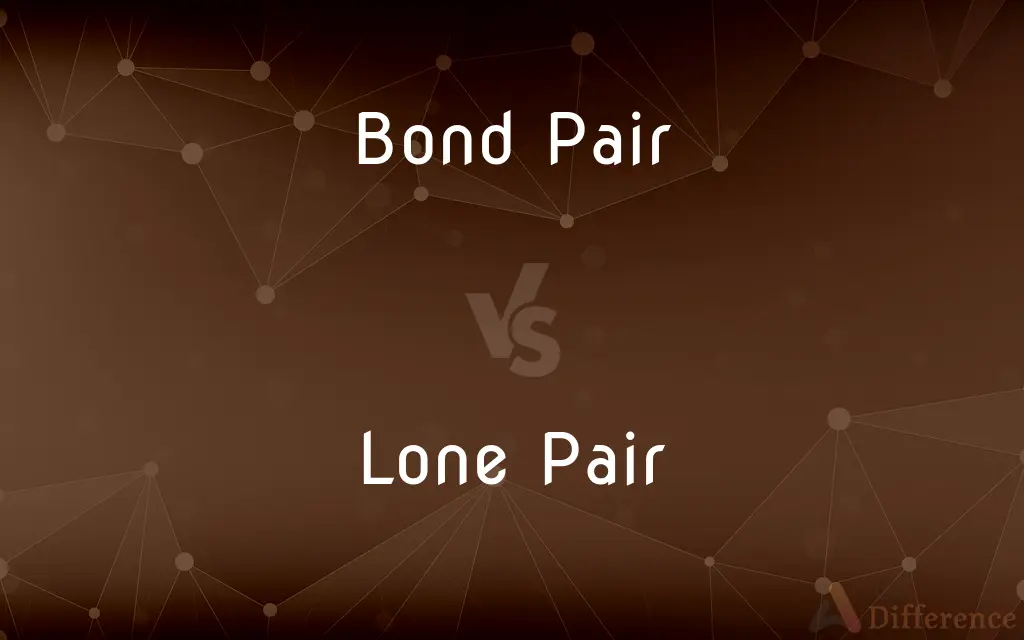Bond Pair vs. Lone Pair — What's the Difference?
By Tayyaba Rehman — Published on November 26, 2023
A Bond Pair consists of two electrons forming a chemical bond, while a Lone Pair is two valence electrons not involved in bonding.

Difference Between Bond Pair and Lone Pair
Table of Contents
ADVERTISEMENT
Key Differences
In the realm of molecular chemistry, understanding electron arrangements is pivotal. One such distinction is between Bond Pair and Lone Pair. A Bond Pair refers to a pair of electrons that are shared between two atoms, forming a chemical bond. This bond can be either covalent, where atoms share electrons, or ionic, where one atom gives an electron to another. Contrastingly, a Lone Pair is a pair of valence electrons present in an atom that is not shared or bonded with another atom. These electrons remain localized on the atom.
Diving deeper, the presence of Bond Pair electrons leads to the formation of molecules. The sharing of these electrons allows atoms to attain a stable electronic configuration. In contrast, Lone Pair electrons, being non-bonding, play a crucial role in determining the shape and reactivity of a molecule. They occupy more space than bonding pairs, often leading to deviations in bond angles.
Furthermore, while Bond Pair electrons are directly involved in holding atoms together in a molecule, Lone Pair electrons can influence molecular properties without directly participating in bonding. For instance, the presence of a Lone Pair can lead to a molecule's polarity. Both Bond Pair and Lone Pair electrons are essential in determining molecular geometry, with Lone Pairs often causing repulsion that alters expected shapes.
Lastly, it's essential to recognize that while every molecule has Bond Pair electrons, not every molecule has Lone Pair electrons. The presence or absence of Lone Pairs and their arrangement greatly influences a molecule's chemical behavior and reactivity.
Comparison Chart
Definition
Electrons involved in bonding
Electrons not involved in bonding
ADVERTISEMENT
Role in Molecules
Formation of molecules
Influences molecule shape and reactivity
Electron Occupation
Between two atoms
Localized on a single atom
Effect on Geometry
Directly determines molecular geometry
Can alter expected molecular geometry
Polarity Influence
Contributes to molecular polarity
Major determinant of molecular polarity
Compare with Definitions
Bond Pair
Bond Pair refers to electrons involved in chemical bonding.
The stability of a hydrogen molecule is attributed to its Bond Pair.
Lone Pair
Lone Pair is electrons localized on a single atom.
Lone Pair electrons on sulfur in sulfur hexafluoride influence its reactivity.
Bond Pair
Bond Pair electrons create covalent or ionic bonds.
In salt, the Bond Pair forms due to the transfer of electrons.
Lone Pair
Lone Pair represents unbonded electrons in molecules.
The Lone Pair in hydroxide ions contributes to its basicity.
Bond Pair
Bond Pair represents shared electrons in a molecule.
The strength of the nitrogen molecule is due to its triple Bond Pair.
Lone Pair
Lone Pair refers to non-bonding electrons in an atom.
Water's bent shape is due to oxygen's two Lone Pairs.
Bond Pair
Bond Pair is electrons contributing to molecular formation.
The Bond Pair in chlorine gas holds the two chlorine atoms together.
Lone Pair
Lone Pair electrons can affect molecular geometry.
The presence of a Lone Pair in ozone gives it a bent structure.
Bond Pair
Bond Pair is two electrons shared between atoms.
The bond between hydrogen and oxygen in water is due to a Bond Pair.
Lone Pair
Lone Pair is two valence electrons not used in bonding.
The Lone Pair on ammonia's nitrogen causes its triangular pyramid shape.
Common Curiosities
How does a Lone Pair influence molecular shape?
A Lone Pair can repel bonding electrons, altering the expected molecular geometry.
What determines the presence of a Lone Pair in an atom?
An atom's valence electrons that aren't used in bonding become Lone Pairs.
Can a molecule have both Bond Pairs and Lone Pairs?
Yes, many molecules, like water, have both Bond Pairs and Lone Pairs.
Are Bond Pair electrons always shared equally?
No, in polar covalent bonds, Bond Pair electrons are shared unequally.
Can Lone Pairs convert into Bond Pairs?
Yes, in certain reactions, Lone Pairs can be involved in bonding, becoming Bond Pairs.
Are Lone Pairs always inactive in reactions?
No, Lone Pairs can participate in reactions, especially in nucleophilic reactions.
Can a Lone Pair's presence affect an atom's hybridization?
Yes, the presence of Lone Pairs can influence an atom's hybridization in a molecule.
Can Bond Pairs affect a molecule's polarity?
Yes, Bond Pairs in polar covalent bonds can make a molecule polar.
What is the main function of a Bond Pair?
A Bond Pair holds two atoms together by sharing electrons.
Which occupies more space: Bond Pair or Lone Pair?
Lone Pairs generally occupy more space than Bond Pairs.
Do Bond Pairs always indicate molecule stability?
While Bond Pairs contribute to stability, other factors like resonance also play a role.
Is the number of Bond Pairs equal to the molecule's bond order?
Not always. For instance, a triple bond has three Bond Pairs but a bond order of three.
Are all Bond Pairs located in the same plane?
No, Bond Pairs can be located in different planes, depending on the molecule's geometry.
Which electrons, Bond Pair or Lone Pair, are more polarizable?
Lone Pairs are generally more polarizable as they are less tightly held.
Do all atoms in a molecule have Lone Pairs?
No, only certain atoms might have Lone Pairs, depending on their electron configuration.
Share Your Discovery

Previous Comparison
Alpha Kappa Alpha vs. Delta Sigma Theta
Next Comparison
Bubble Point vs. Dew PointAuthor Spotlight
Written by
Tayyaba RehmanTayyaba Rehman is a distinguished writer, currently serving as a primary contributor to askdifference.com. As a researcher in semantics and etymology, Tayyaba's passion for the complexity of languages and their distinctions has found a perfect home on the platform. Tayyaba delves into the intricacies of language, distinguishing between commonly confused words and phrases, thereby providing clarity for readers worldwide.
















































